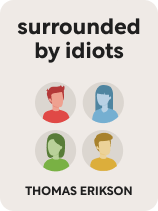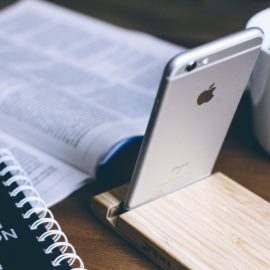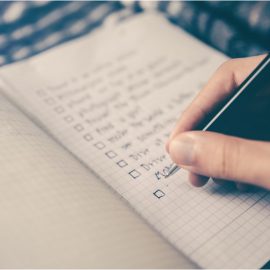

This article is an excerpt from the Shortform book guide to "Surrounded by Idiots" by Thomas Erikson. Shortform has the world's best summaries and analyses of books you should be reading.
Like this article? Sign up for a free trial here .
How do the Red, Yellow, Green, and Blue personality types respond to stress? What can you do to help each color relieve their stress?
Thomas Erikson, the author of Surrounded by Idiots, says that each of the four different personality colors has unique stress triggers, and so each one must be treated differently. Knowing what stresses out each type of person is especially helpful in the workplace.
Continue reading to learn about personality types and stress.
Stress Triggers and Responses
In Surrounded by Idiots, Thomas Erikson says each personality type has its own driving forces—the stuff that motivates them to get out of bed each morning. He says when people don’t give enough time and energy to these driving forces and are pressured to perform in areas that feel foreign, the result is massive stress.
In his book, Erikson helps you understand the personality types and stress triggers and predict how each will respond. By doing so, you can avoid the triggers more easily and tailor your response.
Furthermore, if you serve in a leadership role, knowing and mitigating the stress triggers of your employees will encourage a more efficient and pleasant work environment for everyone.
Stress Triggers for Red Personality Types
Erikson says the following factors trigger a stress response in Red personalities:
- Lack of authority: They like to be in charge of people and make all of the important decisions. They will feel stressed if they have to answer to someone else or ask permission to act.
- Time wasters: They need to see immediate headway on a task. If they feel you’re wasting time due to excessive talking, a nonchalant pace, or lack of results, they’ll be on edge.
- Bureaucracy: They’re big-picture thinkers and don’t do well with bureaucratic procedure. If they’re asked to fill out a stack of forms, or explain their plan in detail, their day will be ruined.
- Routine busy work: They need to feel like they’re solving a problem. If everything is running too smoothly and they’re not challenged, they feel useless and discouraged.
- Being told to calm down: They run hot, but this doesn’t necessarily mean that they’re angry. In fact, if they’re accused of being angry or told to calm down, this produces the opposite of the intended effect.
| Enneagram Eights and the Fear of Weakness In the Enneagram model, Erikson’s Red personality type most closely resembles Type Eight, also known as “The Challenger.” Eights are described as confident, strong, and assertive. Their greatest desire in life is to be in control of themselves, and they want to prove that they are strong and self-reliant. When their decisions are made by another person, they feel vulnerable and weak—and this is their greatest fear. As a way of showing strength and autonomy in the face of these stressors, Eights are prone to overworking themselves and burning out. Eights can combat their fear of weakness and reduce stress by learning to embrace vulnerability. Over time, they will learn that being vulnerable is a sign of strength. |
How Red Personalities Respond to Stress
Erikson says when a Red-dominant person feels stressed, he lashes out and blames others, and his driven nature and high expectations intensify. He will shut everyone out, put his head down, and complete all of the work by himself.
If you’re the Red type’s superior, Erikson says you can help alleviate his stress by excusing him from the office and encouraging him to engage in a physical activity. For example, you might say, “I can see that you’re frustrated. Why don’t you go for a run and come back later.” The idea is that a Red personality’s anger will burn off with his physical exertion.
(Shortform note: Suggesting someone exercise can be risky. Before speaking, first consider whether this person normally engages in physical activities. If they do, then they likely will appreciate the opportunity to do so; if they don’t, it can come across as insulting or overbearing.)
Stress Triggers for Yellow Personality Types
Erikson says the following factors will trigger a stress response in Yellow personalities:
- Negative people: Yellow-dominant people are eternal optimists, so when others explain why an idea won’t work (or point out the obstacles) this makes them frustrated and tense.
- Structured schedules: They love to stay busy, but they hate routine and repetition. If they aren’t given freedom over their schedule and room to be spontaneous, they’ll feel smothered and immobilized.
- Isolation: As extroverted social butterflies, they need the company of others to feel balanced. Isolated Yellow types feel restless and uncomfortable.
- Continual conflict: They don’t mind occasional conflict, but if an environment is chronically negative, they’ll feel as if their life forces are being drained.
- Feeling invisible: They thrive on the spotlight and want to be heard. If they’re not being invited into discussions or activities, this is stressful for a Yellow type.
| Enneagram Sevens and the Stress of Overcommitment In the Enneagram model, Erikson’s Yellow personality type most closely translates to Type Seven, also known as “The Enthusiast.” Sevens are described as extroverted, creative, fun-loving, and optimistic. Their greatest desires are freedom and self-fulfillment. Sevens like to be in charge of their own schedule and have the flexibility to take advantage of exciting opportunities, so when they feel restricted in any way, this is very stressful. A frequent stressor for Sevens is overcommitment. Because they have so many ideas, Sevens like to start projects but often lose interest shortly after. Reminders, deadlines, and incomplete tasks can quickly overwhelm Sevens. Sevens can combat the stress of overcommitment by waiting a day or two before committing to a new project. By delaying their decision for a short period of time, they can avoid a pile-up of impulsive whims. |
How Yellow Personalities Respond to Stress
Erikson says a Yellow-dominant person’s way of dealing with stress is to become even more Yellow. That is to say, she’ll become more talkative, more optimistic (to an outlandish degree), and more energetic. He says she’ll do whatever it takes to be the center of attention.
Erikson says you can help a Yellow type manage her stress by allowing her to be in a social situation—and it’s even better if she can plan it. For example, when a Yellow-dominant person is feeling frazzled, suggest that she plan a fun night out with the team to boost morale. Erikson asserts that the act of planning a social event is often enough to pull a Yellow type out of her stressed state.
(Shortform note: If the Yellow personality is stressed because of overcommitment (as the Enneagram model above suggests), it might be a bad idea to assign her another new task. Consider having a talk with her and asking if she feels overwhelmed or understimulated, and respond accordingly. If she is overwhelmed, offer to take something off of her plate, or help her prioritize her commitments. If she is understimulated, then you can suggest she plan a social event.)
Stress Triggers for Green Personality Types
Erikson says the following factors will trigger a stress response in Green personalities:
- Frenetic environments: Green-dominant people are relationship-driven and love other people, but they need alone time and silence to operate at top gear. Loud and chaotic environments (especially when sustained over long periods of time) drain their energy.
- Sudden changes: They take their time with decisions, so when a directive suddenly changes or they’re asked to make a split-second choice, this is very stressful.
- Failure: Failure is difficult for everyone, but Green personalities especially despise it. They tend to see it as a reflection of their own self-worth.
- Family disagreements: Conflict in the workplace makes them feel uncomfortable, but conflict in the family will keep them up all night with worry.
- The spotlight: If they’re asked to give a presentation to a large group, they’ll be consumed with anxiety until it’s over.
| Enneagram Nines and the Stress of Making Decisions In the Enneagram model, Erikson’s Green personality type most closely translates to Type Nine, also known as “The Peacemaker.” Nines are described as supportive, empathetic, and stable. Their greatest desire is to have peace of mind. Conflict, high-energy situations, and the natural ups and downs of life are very stressful for Nines. A frequent stressor for Nines is decision-making. Because they are so focused on helping others and keeping the peace, they often lose sight of what they want for themselves and feel pressured to make the perfect choice. In the short term, Nines can alleviate the stress of making decisions by asking the requestor to narrow the options down to a few choices. In the long-term, Nines would benefit from working with a professional on their indecisiveness. |
How Green Personalities Respond to Stress
When Green-dominant people are feeling stressed, Erikson says they’re apt to completely shut down. Usually the most empathetic of all the colors, they’ll switch gears into total apathy. Erikson warns that Green types become paralyzed with a fear of handling the situation incorrectly and will inflict internal blame and shame.
Erikson says you can help Green personalities manage their stress by giving them space and time to do nothing. He says when Greens are stressed, they need to reset by doing a relaxing activity (or sleeping), either by themselves or in a very small group. In a workplace, this might look like giving them the afternoon off, or asking them to dedicate the rest of the day to some isolated activity that doesn’t require any decision-making.
(Shortform note: Psychologists say that spending time alone can help “reboot” your brain. In a set of studies performed on college students, researchers drew a connection between solitude and emotional regulation. They had some participants spend time alone and had some spend time conversing with others. After only 15 minutes alone, participants reported lower levels of high-energy emotions (such as excitement or anxiety), and higher levels of low-energy emotions (such as tranquility and relaxation). The same effect was not achieved by participants who spent that time conversing with others.)
Stress Triggers for Blue Personality Types
Erikson says the following factors will trigger a stress response in Blue personalities:
- Spontaneous changes: They’re OK with change, but only if proper planning is done. Spontaneous changes in direction with no solid rationale make Blue types uncomfortable and irritable.
- Risky decisions: They are extremely risk-averse. They prefer tried-and-true procedures over spontaneity (even if spontaneity yields great innovation). If you ask them to “loosen up” or “take a chance,” they become angry and flustered.
- Surprise plans: Even if they don’t communicate it to you, Blue personalities have their schedules mapped out in detail. Unexpected plans, such as drop-in visits, irritate Blue types.
- Silly mistakes: They view mistakes as the result of carelessness, and they’re extremely careful people. If you consistently make small mistakes in front of Blue-dominant people, they’ll hate working with you.
- Emotional people: They aren’t devoid of emotion, but they keep it inside. People who show emotional distress to others make Blue personality types uncomfortable—to them, emotional outbursts signal a lack of logical thinking.
| Enneagram Sixes and the Stress of Uncertainty In the Enneagram model, Erikson’s Blue most closely resembles Type Six, also known as “The Loyalist.” Sixes are described as hard-working, responsible, and trustworthy. Prone to anxiety and pessimism, their greatest desire is security. Sixes enjoy planning for all possible outcomes but often doubt themselves and avoid making decisions. A frequent stressor for Sixes is uncertainty about the future. When faced with a new experience or situation, Sixes can become paralyzed with worry and panic. To combat this fear of the unknown, Sixes should define their criteria for preparation and learn to make peace with what is in their control. |
How Blue Personalities Respond to Stress
Erikson says when Blue-dominant people experience stress, they slow way down. Suddenly none of their tasks are getting done, and they’ll instead double-down on their pessimism. Where they might have pointed out obvious mistakes before, Erikson warns they’ll now point out every single mistake they see.
As with Greens, when Blue types are stressed, Erikson recommends you give them space. They need time away from everyone else to sort through the situation and make a new plan. Once they feel they have control again and have analyzed the risks, they’ll relax.
(Shortform note: If you are a chronic worrier, you’ve probably been told many times to “stop worrying so much.” Whether or not you actually should depends on your level of worrying. Small to moderate amounts have been shown to be beneficial, because it motivates people to take smart action against risks. Quitting smoking, wearing a seatbelt, and avoiding drugs are all related to a bit of worry. Too much worry, however, can negatively affect every part of your health, from your sleep to your cardiovascular system. If you find that your worrying is persistent and debilitating, this is the time to seek help.)

———End of Preview———
Like what you just read? Read the rest of the world's best book summary and analysis of Thomas Erikson's "Surrounded by Idiots" at Shortform .
Here's what you'll find in our full Surrounded by Idiots summary :
- A detailed look at Thomas Erikson's four personality types
- How to navigate conflicts with coworkers
- How to effectively communicate and collaborate with bosses, employees, and colleagues







Hi Hannah, thanks for the article, it gives great insights!
One question, I noticed you use ‘his’ and ‘her’. For example ‘his’ (him/ male) when talking about the red personality type and ‘her’ (female) for the yellow type. What has lead to the decision to use her and him and him for red and her for yellow? Is this cause we associate the colours with gender (red, action orientated = man, yellow, people orientated = female) or yin/ yang for example? Please let me know how I can relate gender to the colours, thanks! 🙂
Hi Hannah,
It us a great insight.
After I read the book, I think I have all the colours attribute – not all attribute but some of it.
However, in the beginning of the chapter, the author did stated 80% has 2 colors, 5% has dominant 1 color & the rest (15%) have 3 color combination. Nothing stated individu that has 4 color combination.
Can you help me to understad this better as this reading actually can help me to understand myself better to able to carry my role and to develop my team memebr as well as to understand my audience (client).
Hope you can help me 🙂